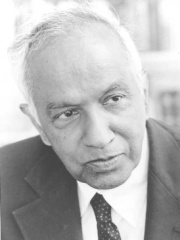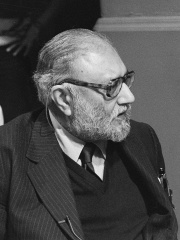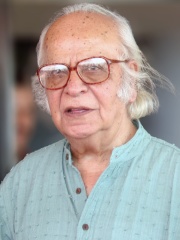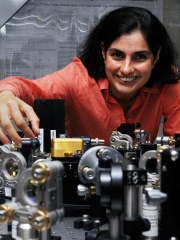



The Most Famous
PHYSICISTS from Pakistan
This page contains a list of the greatest Pakistani Physicists. The pantheon dataset contains 851 Physicists, 4 of which were born in Pakistan. This makes Pakistan the birth place of the 27th most number of Physicists behind South Africa, and Australia.
Top 4
The following people are considered by Pantheon to be the most legendary Pakistani Physicists of all time. This list of famous Pakistani Physicists is sorted by HPI (Historical Popularity Index), a metric that aggregates information on a biography's online popularity.

1. Subrahmanyan Chandrasekhar (1910 - 1995)
With an HPI of 71.06, Subrahmanyan Chandrasekhar is the most famous Pakistani Physicist. His biography has been translated into 86 different languages on wikipedia.
Subrahmanyan Chandrasekhar ( CHƏN-drə-SHAY-kər; Tamil: சுப்பிரமணியன் சந்திரசேகர், romanized: Cuppiramaṇiyaṉ Cantiracēkar; 19 October 1910 – 21 August 1995) was an Indian-American theoretical physicist who made significant contributions to the scientific knowledge about the structure of stars, stellar evolution and black holes. He also devoted some of his prime years to fluid dynamics, especially stability and turbulence, and made important contributions. He was awarded the 1983 Nobel Prize in Physics along with William A. Fowler for theoretical studies of the physical processes of importance to the structure and evolution of the stars. His mathematical treatment of stellar evolution yielded many of the current theoretical models of the later evolutionary stages of massive stars and black holes. Many concepts, institutions and inventions, including the Chandrasekhar limit and the Chandra X-Ray Observatory, are named after him. Born in the late British Raj, Chandrasekhar worked on a wide variety of problems in physics during his lifetime, contributing to the contemporary understanding of stellar structure, white dwarfs, stellar dynamics, stochastic process, radiative transfer, the quantum theory of the hydrogen anion, hydrodynamic and hydromagnetic stability, turbulence, equilibrium and the stability of ellipsoidal figures of equilibrium, general relativity, mathematical theory of black holes and theory of colliding gravitational waves. At the University of Cambridge, he developed a theoretical model explaining the structure of white dwarf stars that took into account the relativistic variation of mass with the velocities of electrons that comprise their degenerate matter. He showed that the mass of a white dwarf could not exceed 1.44 times that of the Sun – the Chandrasekhar limit. Chandrasekhar revised the models of stellar dynamics first outlined by Jan Oort and others by considering the effects of fluctuating gravitational fields within the Milky Way on stars rotating about the galactic centre. His solution to this complex dynamical problem involved a set of twenty partial differential equations, describing a new quantity he termed "dynamical friction", which has the dual effects of decelerating the star and helping to stabilize clusters of stars. Chandrasekhar extended this analysis to the interstellar medium, showing that clouds of galactic gas and dust are distributed very unevenly. Chandrasekhar studied at Presidency College, Madras (now Chennai) and the University of Cambridge. A long-time professor at the University of Chicago, he did some of his studies at the Yerkes Observatory, and served as editor of The Astrophysical Journal from 1952 to 1971. He was on the faculty at Chicago from 1937 until his death in 1995 at the age of 84, and was the Morton D. Hull Distinguished Service Professor of Theoretical Astrophysics.

2. Abdus Salam (1926 - 1996)
With an HPI of 69.53, Abdus Salam is the 2nd most famous Pakistani Physicist. His biography has been translated into 82 different languages.
Mohammad Abdus Salam (; pronounced [əbd̪ʊs səlaːm]; 29 January 1926 – 21 November 1996) was a Pakistani theoretical physicist. He shared the 1979 Nobel Prize in Physics with Sheldon Glashow and Steven Weinberg for his contribution to the electroweak unification theory. He was the first Pakistani, first Muslim scientist, and second person from any Muslim country (after Anwar Sadat of Egypt) to win a Nobel Prize. Salam was scientific advisor to the Ministry of Science and Technology in Pakistan from 1960 to 1974, a position from which he played a major and influential role in the development of the country's science infrastructure. Salam contributed to numerous developments in theoretical and particle physics in Pakistan. He was the founding director of the Space and Upper Atmosphere Research Commission (SUPARCO), and responsible for the establishment of the Theoretical Physics Group (TPG). For this, he is viewed as the "scientific father" of this program. In 1974, Abdus Salam departed from his country in protest after the Parliament of Pakistan unanimously passed a parliamentary bill declaring members of the Ahmadiyya Muslim community, to which Salam belonged, non-Muslim. In 1998, following the country's Chagai-I nuclear tests, the Government of Pakistan issued a commemorative stamp, as a part of "Scientists of Pakistan", to honour the services of Salam. Salam's notable achievements include the Pati–Salam model, a Grand Unified Theory he proposed along with Jogesh Pati in 1974, magnetic photon, vector meson, work on supersymmetry and most importantly, electroweak theory, for which he was awarded the Nobel Prize. Salam made a major contribution in quantum field theory and in the advancement of Mathematics at Imperial College London. With his student, Riazuddin, Salam made important contributions to the modern theory on neutrinos, neutron stars and black holes, as well as the work on modernising quantum mechanics and quantum field theory. As a teacher and science promoter, Salam is remembered as a founder and scientific father of mathematical and theoretical physics in Pakistan during his term as the chief scientific advisor to the president. Salam heavily contributed to the rise of Pakistani physics within the global physics community. Up until shortly before his death, Salam continued to contribute to physics, and to advocate for the development of science in third-world countries.

3. Yash Pal (1926 - 2017)
With an HPI of 46.28, Yash Pal is the 3rd most famous Pakistani Physicist. His biography has been translated into 15 different languages.
Yash Pal (26 November 1926 – 24 July 2017) was an Indian scientist, educator and educationist. He was known for his contributions to the study of cosmic rays, as well as for being an institution-builder. In his later years, he became one of the leading science communicators of the country. Starting his career at Tata Institute of Fundamental Research (TIFR), he later remained Chairman of the University Grants Commission from 1986 to 1991. In 2013, he was awarded India's second highest civilian honour, the Padma Vibhushan.

4. Nergis Mavalvala (b. 1968)
With an HPI of 39.40, Nergis Mavalvala is the 4th most famous Pakistani Physicist. Her biography has been translated into 19 different languages.
Nergis Mavalvala (born 1968) is a Pakistani-American astrophysicist. She is the Curtis and Kathleen Marble Professor of Astrophysics at the Massachusetts Institute of Technology (MIT), where she is also the dean of the university's school of science. She was previously the Associate Head of the university's Department of Physics. Mavalvala is best known for her work on the detection of gravitational waves in the Laser Interferometer Gravitational-Wave Observatory (LIGO) project, and for the exploration and experimental demonstration of macroscopic quantum effects such as squeezing in optomechanics. She was awarded a MacArthur Fellowship in 2010.
People
Pantheon has 4 people classified as Pakistani physicists born between 1910 and 1968. Of these 4, 1 (25.00%) of them are still alive today. The most famous living Pakistani physicists include Nergis Mavalvala. The most famous deceased Pakistani physicists include Subrahmanyan Chandrasekhar, Abdus Salam, and Yash Pal.
Living Pakistani Physicists
Go to all RankingsDeceased Pakistani Physicists
Go to all RankingsSubrahmanyan Chandrasekhar
1910 - 1995
HPI: 71.06
Abdus Salam
1926 - 1996
HPI: 69.53
Yash Pal
1926 - 2017
HPI: 46.28
Overlapping Lives
Which Physicists were alive at the same time? This visualization shows the lifespans of the 3 most globally memorable Physicists since 1700.

